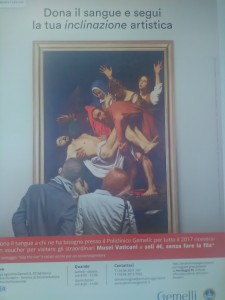I recently saw a rather alarming poster advertizing a blood drive The title is “donate bllod and follow your artistic inclinations” which, given the image, I interpreted as “donate blood and faint, so that you are inclined head down just like the recently crucified Christ. You will be resurrected too (by some fluids not the holy spirit).” Oddly, it seems the advertizing agency didn’t notice the potentially alarming relationship between the image and a (rather rare) side effect of blood donation. They also didn’t consider the literal meaning of “inclinazione” when writing about an extremely inclined figure. Closer reading reveals that The One True Catholic and Apostolic Church is, in a sense, paying for blood. “Donors” receive discounts on tickets to the vatican museums. This raises an issue related to economic theory and justifies an AngryBear post. “Tranfused Blood, Serum Hepatitis, and the Coase Theorem” is a fundamentally important article about market failure in the presence of asymmetric information. The authors noted that it is much cheaper to buy blood than to convince people to give it. But the bought blood isn’t as good, being more likely to contain hepatitis virus.
Topics:
Robert Waldmann considers the following as important: Uncategorized
This could be interesting, too:
tom writes The Ukraine war and Europe’s deepening march of folly
Stavros Mavroudeas writes CfP of Marxist Macroeconomic Modelling workgroup – 18th WAPE Forum, Istanbul August 6-8, 2025
Lars Pålsson Syll writes The pretence-of-knowledge syndrome
Dean Baker writes Crypto and Donald Trump’s strategic baseball card reserve
I recently saw a rather alarming poster advertizing a blood drive
The title is “donate bllod and follow your artistic inclinations” which, given the image, I interpreted as “donate blood and faint, so that you are inclined head down just like the recently crucified Christ. You will be resurrected too (by some fluids not the holy spirit).”
Oddly, it seems the advertizing agency didn’t notice the potentially alarming relationship between the image and a (rather rare) side effect of blood donation. They also didn’t consider the literal meaning of “inclinazione” when writing about an extremely inclined figure.
Closer reading reveals that The One True Catholic and Apostolic Church is, in a sense, paying for blood. “Donors” receive discounts on tickets to the vatican museums.
This raises an issue related to economic theory and justifies an AngryBear post. “Tranfused Blood, Serum Hepatitis, and the Coase Theorem” is a fundamentally important article about market failure in the presence of asymmetric information. The authors noted that it is much cheaper to buy blood than to convince people to give it. But the bought blood isn’t as good, being more likely to contain hepatitis virus. The point is that if someone gives with the intent to help, they care about the quality of their gift, and follow instructions to not donate if, for example, they self inject drugs. People who sell include many who care only about the money. Since the donor (or seller) knows more about the donor’s behavior and risk of hepatitis infection than the blood collectors, the market fails.
This is a really important article (or an early cite of an earlier really important article — Google Scholar gets weak going back to 1974).
But, it seems to me, that the One True Catholic and Apostolic Church has found a trick — a way to pay and select. The point is that intravenous drug addicts etc may be desperate for money and eager to sell blood for cash, but they are not so desperately eager to get discounts on tickets to art museums to be willing to lie and endager others to get them. Even the relatively art loving heroin addict will probably want to save the money rather than buy even discounted tickets to an art museum.
So paying with a “merit good” (don’t ask me to define or even type without scare quotes) can be a rational strategy to use the market even in this case of asymmetric information.
I do not have a rationale for bringing up crucifixion, when trying to convince people to let other people stick sharp things into them.

